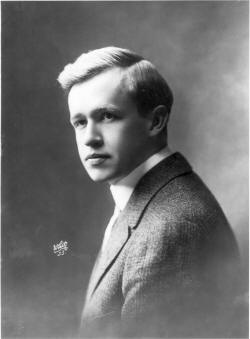

Partner John Floyd
Queer Places:
University of Michigan, Ann Arbor, Michigan, Stati Uniti
Riverside Cemetery, 3607 Pearl Rd, Cleveland, OH 44109, Stati Uniti

Hopwood was born to James and Jule Hopwood on May 28, 1882, in Cleveland, Ohio.[1] He graduated from Cleveland's West High School in 1900.[2] In 1901, he began attending the University of Michigan in Ann Arbor. However, his family experienced financial difficulties, so for his sophomore year he transferred to Adelbert College. He returned to the University of Michigan in the fall of 1903, and graduated Phi Beta Kappa in 1905.[3]
Hopwood started out as a journalist for a Cleveland newspaper as its New York correspondent, but within a year had a play, Clothes (1906), produced on Broadway. He became known as "The Playboy Playwright"[4] and specialized in comedies and farces, some of them with material considered risqué at the time. One play, The Demi-Virgin in 1921, prompted a court case because of its suggestive subject matter, including a risque game of cards, "Stripping Cupid", where a bevy of showgirls teased the audience in their lingerie. The case was dismissed.
His many plays included Nobody's Widow (1910), starring Blanche Bates; Fair and Warmer (1915), starring Madge Kennedy (filmed in 1919); The Gold Diggers (1919), starring Ina Claire (filmed in 1923 as The Gold Diggers, in 1928 as Gold Diggers of Broadway and also as Gold Diggers of 1933); Ladies' Night, 1920, starring Charlie Ruggles (filmed in 1928); the famous mystery play The Bat (with Mary Roberts Rinehart), 1920 (filmed in 1926 as The Bat, in 1930 as The Bat Whispers, and in 1959 as The Bat); Getting Gertie's Garter (with Wilson Collison), 1921, starring Hazel Dawn (filmed in 1927 and 1945); The Demi-Virgin, 1921, also starring Dawn; The Alarm Clock, 1923; The Best People (with David Gray), 1924 (filmed in 1925 and as Fast and Loose in 1930), the song-farce Naughty Cinderella, 1925, starring Irene Bordoni and The Garden of Eden in 1927 (filmed in 1928 as The Garden of Eden).
Hopwood was asked to write the third act of Mary Roberts Rinehart's play The Bat.[5] Hopwood collaborated with Rinehart to then work on the last act of the play in Sewickley and sometimes in New York.[5]
The early sound film The Bat Whispers played an influence on Bob Kane's Batman because the inspiration for Batman's costume came from the "mysterious Bat" character portrayed in the movie from 1930.[6]
In 1906, Hopwood was introduced to writer and photographer Carl Van Vechten. The two became close friends and were sometimes sexual partners.[7] In the 1920s Hopwood had a tumultuous and abusive romantic relationship with fellow Cleveland-born playwright John Floyd.[8] Although Hopwood announced to the press in 1924 that he was engaged to vaudeville dancer and choreographer Rosa Rolanda, Van Vechten confirmed in later years that it was a publicity stunt. Rolanda would later marry caricaturist Miguel Covarrubias.
On July 1, 1928, while swimming at Juan-les-Pins on the French Riviera, Hopwood had a heart attack and died. He was buried in Riverside Cemetery, Cleveland.[9] His mother, Jule Hopwood, inherited a large trust from him, but he had not made arrangements for the disposition of other items, including literary rights. While she was working through the legal issues with his estate, Jule Hopwood fell ill and died on March 1, 1929. She was buried next to her son.[10]
My published books: